- 1Republic of Türkiye Ministry of Agriculture and Forestry Central Fisheries Research Institute, Trabzon, Türkiye
- 2General Fisheries Commission for the Mediterranean, Food and Agriculture Organization of the United Nations, Rome, Italy
- 3National Research Council, Institute for Marine Biological Resources and Biotechnology (CNR-IRBIM), Ancona, Italy
Marine recreational fishing, a globally popular outdoor activity, has deep cultural roots and ecological implications. This study, conducted between 2021-2022, explores marine recreational fishing practices along the Turkish Black Sea coast. It analyzes fisher numbers and demographics, fishing effort, fishing methods, and species caught and released. Furthermore, the research sheds light on the economic dimensions, emphasizing the substantial contributions of recreational fishing to local economies. Notably, responsible practices, such as catch-and-release initiatives, demonstrate anglers’ awareness of conservation efforts. Within the Turkish Black Sea region, an observed 18.5% participation rate among a population of 24.5 million implies the presence of approximately 4.5 million marine recreational fishers. Annually, this translates to nearly 30 million fishing days, accompanied by a total expenditure of 400 million Euros. However, it’s imperative to handle these figures cautiously as the timing of the screening survey during the COVID-19 pandemic may have influenced the high participation rate, introducing a potential bias. A detailed examination of a Turkish marine recreational fisher engaged in Black Sea fishing reveals an average annual catch of 16.5 kg of retained fish and 1.2 kg of released fish biomass. When extrapolated to the larger population of 4.5 million fishers, this culminates in a noteworthy landing biomass approaching 74,000 tons. The study unveils that marine recreational fishers in the Turkish Black Sea predominantly target commercially important species, resulting in a retained biomass surpassing commercial landings in 2021. This prompts concerns about potential impacts on crucial commercial fish stocks, underscoring the imperative inclusion of recreational fisheries in stock assessments. The research, providing essential insights into the intricate dynamics of recreational fishing, lays a foundation for well-informed policies and practices that concurrently promote environmental conservation and the continuation of this valued leisure activity.
1 Introduction
Marine recreational fishing (MRF) is a widespread and highly popular outdoor activity that has deep historical and cultural roots across the globe. Engaging in this recreational activity, often seen as a harmonious fusion of art and science, revolves around the pursuit and capture of diverse aquatic organisms. Enthusiasts partake in this endeavor purely for the delight and excitement it brings, relishing the challenge it presents (Cowx and Arlinghaus, 2008; Cooke et al., 2018). MRF represents a multifaceted pastime encompassing a wide range of techniques, equipment, and settings, and it holds a unique place within the broader context of environmental conservation, natural resource management, and socio-economic impact (Tweedley et al., 2023). Beyond its cultural significance, MRF has profound ecological implications. Its close relationship with the well-being of aquatic ecosystems is underscored by its reliance on the existence of diverse and healthy fish populations (Pouso et al., 2018). The impact of MRF on marine ecosystems, however, is not limited to the catch itself; it also encompasses habitat degradation, invasive species introductions, and the potential disruption of natural predator-prey dynamics. Consequently, understanding its ecological consequences is crucial for sustainable resource management and biodiversity conservation (Arlinghaus and Cowx, 2008; Butler et al., 2020; Schafft et al., 2021).
From an economic perspective, MRF has emerged as a significant industry, generating substantial revenues worldwide. Anglers contribute to the economy through the purchase of fishing gear, licenses, and permits, as well as by participating in guided fishing tours and travel (Øystein, 2008; Potts et al., 2022). Additionally, this activity supports various ancillary businesses, including tackle shops, boat rentals, and hospitality services in areas frequented by fishers. These economic dimensions underscore the importance of MRF in regional and national economies and highlight the need for responsible management to ensure long-term sustainability (Tsafoutis and Metaxas, 2021).
In contemporary society, MRF is undergoing a transformation in response to evolving environmental concerns and changing demographics. Conservation-oriented practices, catch-and-release initiatives, and sustainable fishing practices have gained prominence among anglers, reflecting a growing awareness of the need to protect aquatic ecosystems (Drymon and Scyphers, 2017). Furthermore, this activity is evolving to embrace a more diverse and inclusive audience, welcoming women, children, and individuals with disabilities. This shift promotes a wider understanding and admiration for the natural world (Ojea et al., 2020).
Fisheries management is a complex and dynamic field that seeks to balance the extraction of aquatic resources with the need to maintain healthy ecosystems and safeguard the interests of various stakeholders (Bastardie et al., 2021; Shen and Song, 2023). Characterized by its diverse techniques and motivations, MRF represents a unique and significant component of contemporary fisheries. This activity can exert substantial pressure on specific fish species, particularly those highly coveted by anglers (Kadagi et al., 2021). Overfishing of popular game fish worldwide (e.g., salmon, sea trout, and seabass) can lead to declines in their populations, potentially disrupting local ecosystems. Fisheries managers must carefully monitor and regulate recreational harvest to prevent unsustainable exploitation. In addition to the target species, MRF can inadvertently capture non-target species (bycatch), including endangered or protected species. Moreover, the use of impacting fishing techniques can harm fragile aquatic habitats, such as coral reefs or seagrass beds, with cascading ecological effects. Effective fisheries management must consider these collateral impacts and implement measures to minimize harm (Grip and Blomqvist, 2020; Cooke et al., 2023).
Given this background, Mediterranean and Black Sea fisheries face serious challenges, with approximately 58 percent of the scientifically assessed stocks considered to be fished outside safe biological limits (FAO, 2023). In the period 2017-2020, the General Fisheries Commission for the Mediterranean (GFCM) developed a programmatic and multiannual mid-term strategy focused on enhancing the sustainability of Mediterranean and Black Sea fisheries. Pertaining to MRF, Output 2.1 of Target 2 within the mid-term strategy outlined the need for “Robust and timely information on the impacts of small-scale fisheries and recreational fisheries on living marine resources and on their interactions with other human activities in coastal communities.” This initiative anticipated the formation of a permanent working group on MRF within the GFCM and the assessment of MRF impacts. It’s important to note that the collection of MRF data was a recent development in many countries, and until recently, there was no clear framework for utilizing this data for stock assessment or fishery management.
The aim of this research was to investigate the recreational fishing activity in the Turkish Black Sea coastal provinces. The research, carried out from 2021 to 2022, adhered to the methodology outlined in the “Handbook for Recreational Fisheries Data Collection in the Mediterranean and Black Sea” (Grati et al., 2021). The study comprised two key phases: first, establishing a statistical framework encompassing marine recreational fishers along the Turkish Black Sea coasts, and second, gathering data to evaluate the effects of recreational fishing activities.
2 Materials and methods
2.1 Study area
The Black Sea occupies a low-lying region running from east to west, nestled between two mountainous ranges: the Pontic Mountains to the south and the Caucasus Mountains to the northeast. This sea connects to the Atlantic Ocean via the Mediterranean and Aegean seas, as well as through the “Turkish Strait System” comprising the Istanbul Strait, Sea of Marmara, and Çanakkale Strait. Additionally, the Kerch Strait links it to the Azov Sea.
Türkiye’s Black Sea coastline stretches approximately 1,600 km, touching 16 provinces. Eight of these provinces have city centers in close proximity to the coast, while the others are situated farther inland (Figure 1). The combined population of these provinces is approximately 26 million. Notably, the western shores of the Black Sea, particularly Istanbul, boast higher population densities, with Istanbul alone housing 15.8 million people.
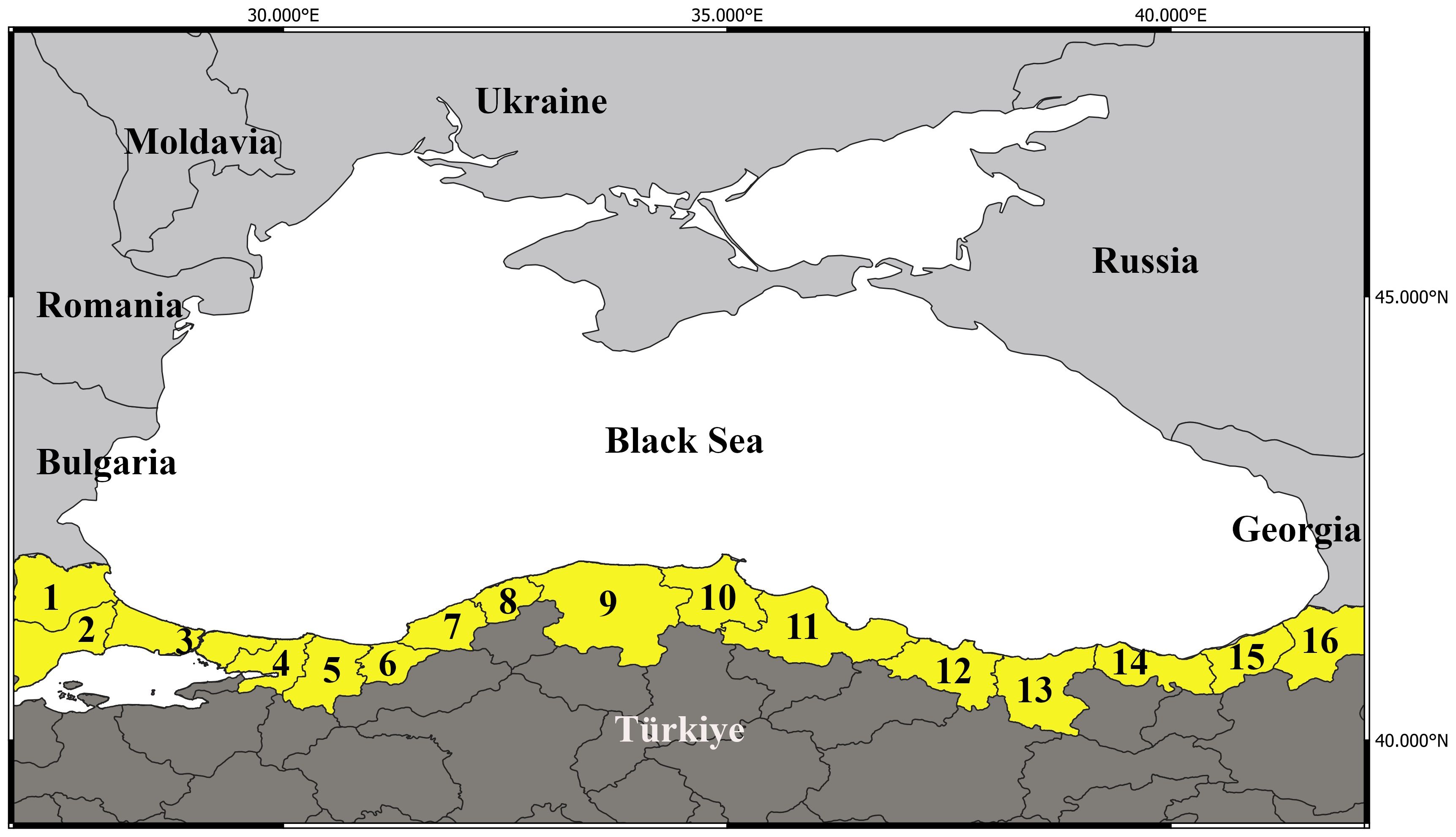
Figure 1 Map showing the 16 provinces along the Turkish Black Sea shoreline. 1 Kirklareli; 2 Tekirdağ; 3 İstanbul; 4 Kocaeli; 5 Sakarya; 6 Düzce; 7 Zonguldak; 8 Bartin; 9 Kastamonu; 10 Sinop; 11 Samsun; 12 Ordu; 13 Giresun; 14 Trabzon; 15 Rize; 16 Artvin.
2.2 Data collection
2.2.1 Telephone screening survey (phase 1)
To estimate the population of marine recreational fishers residing in the 16 districts along the Turkish Black Sea shoreline, a comprehensive survey was conducted in 2021 on a complete roster of resident households. The survey, carried out by the company Survey ARAȘTIRMA, utilized a sample of 3,055 landline phone numbers which were randomly extracted from the Turkish directory for fixed telephones (Table 1). The interviewers underwent training provided by the survey company to familiarize themselves with the purpose and content of the interviews. The sample size was identified in order to have an error of <5%. This selection adhered to a stratified sampling scheme, where design weights were applied to both coastal and non-coastal districts (with a distribution of 70 percent coastal and 30 percent non-coastal) (Table 1). The purpose of this approach was to overrepresent coastal municipalities, where a higher concentration of marine recreational fishers was anticipated (see Bolognini et al., 2022). The primary objective was to identify households with individuals participating in MRF, gather their contact details, and enlist them for a more in-depth follow-up survey (Phase 2).
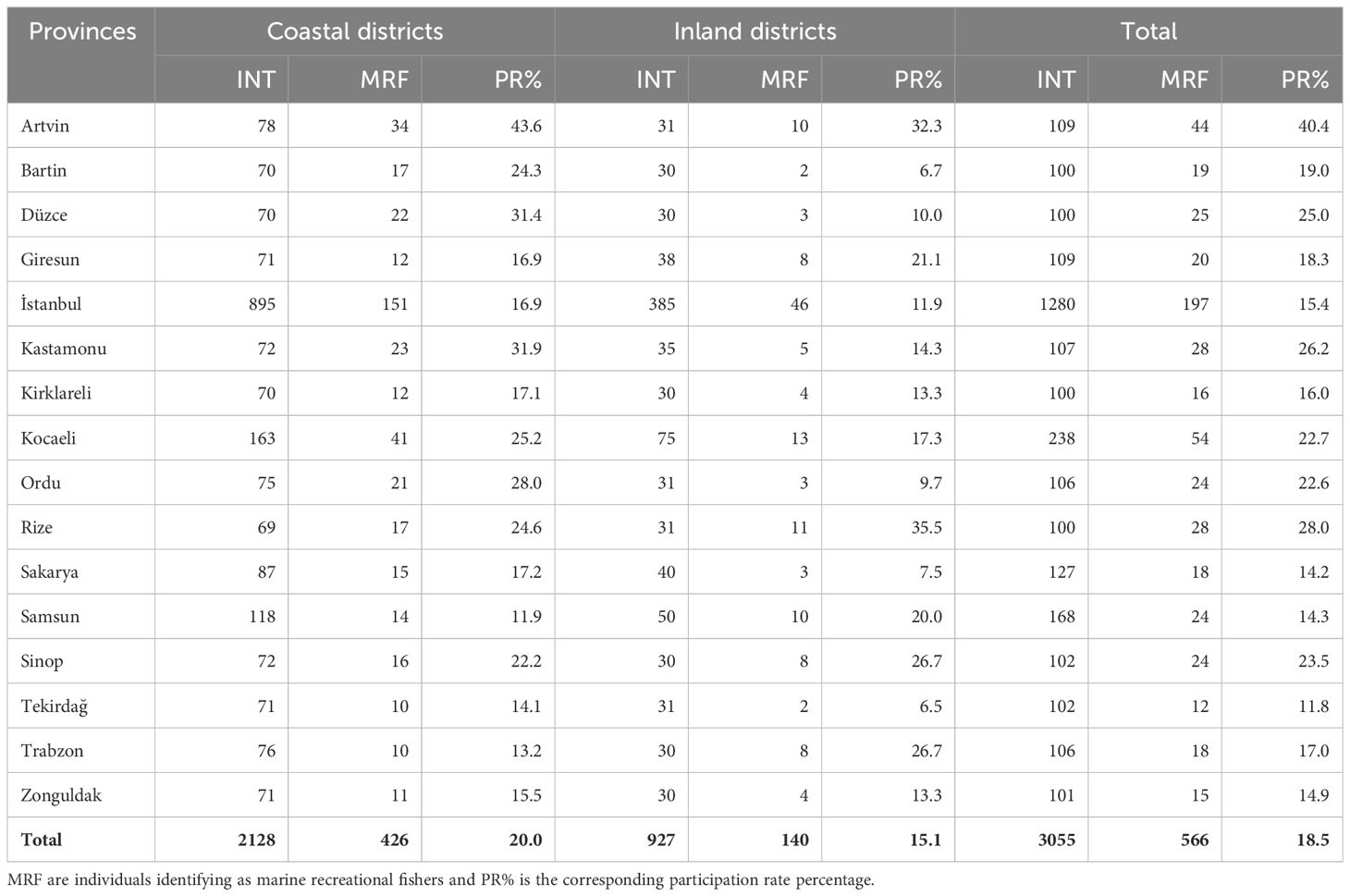
Table 1 Number of interviewed individuals (INT) in coastal and inland districts of Turkish provinces bordering the Black Sea during the telephone screening survey.
The initial respondent was queried on several aspects, including their gender, age, participation in marine recreational fishing, the number of fishing days undertaken in 2020 (avidity) using different fishing methods (such as shore fishing, boat fishing, and underwater fishing), and their willingness to participate in a subsequent follow-up survey panel. Respondents below the age of 16 were excluded from the survey.
2.2.2 Recall survey (phase 2)
Data on catches, effort and expenditures were collected through a recall survey, which relies on contacting, via telephone, the marine recreational fishers identified during the screening survey who agreed to participate in a subsequent follow-up survey panel.
To mitigate potential recall errors, we chose to limit the recall period to one month, as research has shown that longer recall timeframes can introduce bias into survey results (Grati et al., 2021).
We followed the approach outlined by Grati et al. (2021) to gather data on the fishing activities conducted in the preceding month. This included details about the number of fishing trips undertaken using different methods (such as boat, shore, and underwater fishing), the quantity and weight of species caught and released, the Total Length (TL) of each retained and released specimen, and all related expenditures incurred during that period (including equipment, bait, travel, etc.).
3 Results
3.1 Telephone screening survey
Among the 3,055 individuals interviewed, 566 identified themselves as marine recreational fishers, constituting a participation rate of 18.5% (Table 1). The participation rate in coastal districts (20.0%) exceeded that in inland districts (15.1%). In total, 291 recreational fishers agreed to be recontacted for a follow-up panel survey.
The majority of respondents were males (70%), with the most common age group being 36-40 years old (Figure 2).
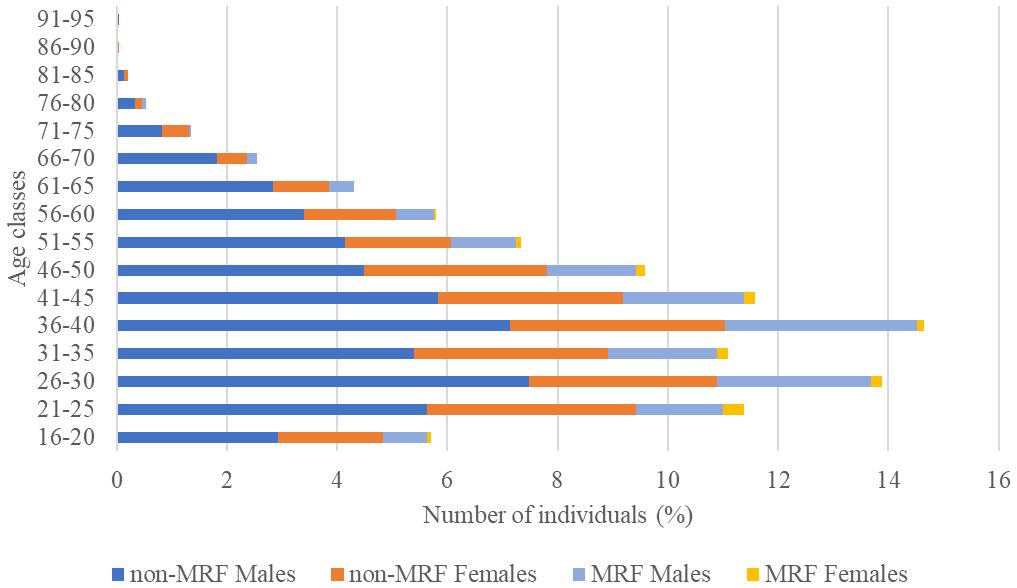
Figure 2 Distribution of age groups among respondents, categorized by gender and individuals identifying as marine recreational fishers (MRF) and non-marine recreational fishers (non-MRF).
The age groups among respondents who identified as marine recreational fishers mirrored those of the overall respondents, but the proportion of males significantly rose to 92% (Figure 2).
In 2020, the majority of fishers (47%) reported engaging in sea fishing a few times, typically ranging from 1 to 5 days (Figure 3). During that year, Turkish recreational fishermen spent an average of 28.4 days fishing in the Black Sea. Nevertheless, this number might be highly inflated because of potential outliers, like those who reported fishing 200-300 times. Therefore, we consider the median value (10.0 days/year) to be a more realistic, and we utilized this figure for subsequent calculations. However, the restricted frequency of fishing trips can be mainly attributed to limitations in available time, adverse weather conditions, particularly prevalent during the winter months, and economic considerations.
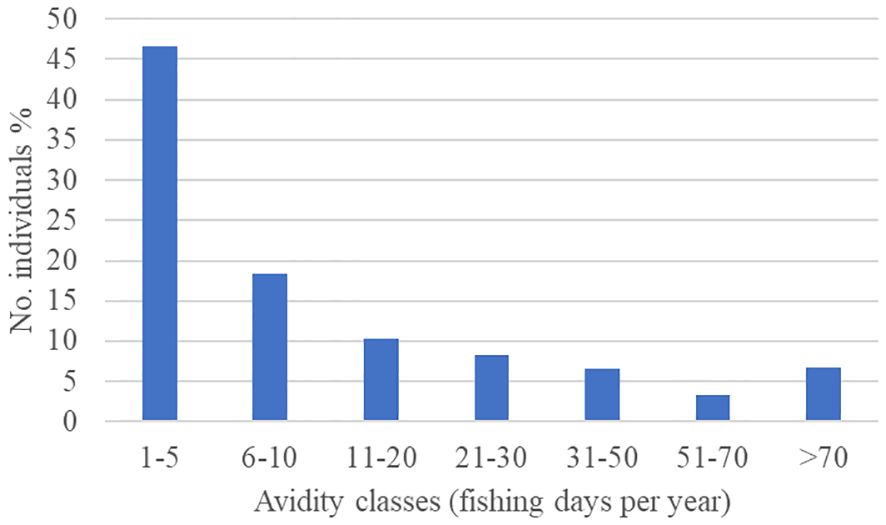
Figure 3 Distribution of days spent fishing at sea during 2020 categorized into different classes of avidity.
3.2 Recall survey
Initially, 291 marine recreational fishers agreed to participate in the recall survey. However, this number gradually decreased to 285 within a few months due to factors such as discontinuation of the activity, relocation to another region, lack of time to participate in the survey, and other reasons.
3.2.1 Fishing effort
Recreational fishers in the Turkish Black Sea region displayed a monthly median fishing activity ranging from 0.0 days in September 2022 to 3.0 days in May and June 2022, indicating a clear seasonality (Figure 4). In total, we calculated an average annual value of 6.85 ( ± 1.3 SD) fishing days during the survey period. This value partially confirms what was already observed in the screening survey, where the majority of respondents (65%) reported going fishing at sea for up to 10 days in 2020 (Figure 3).
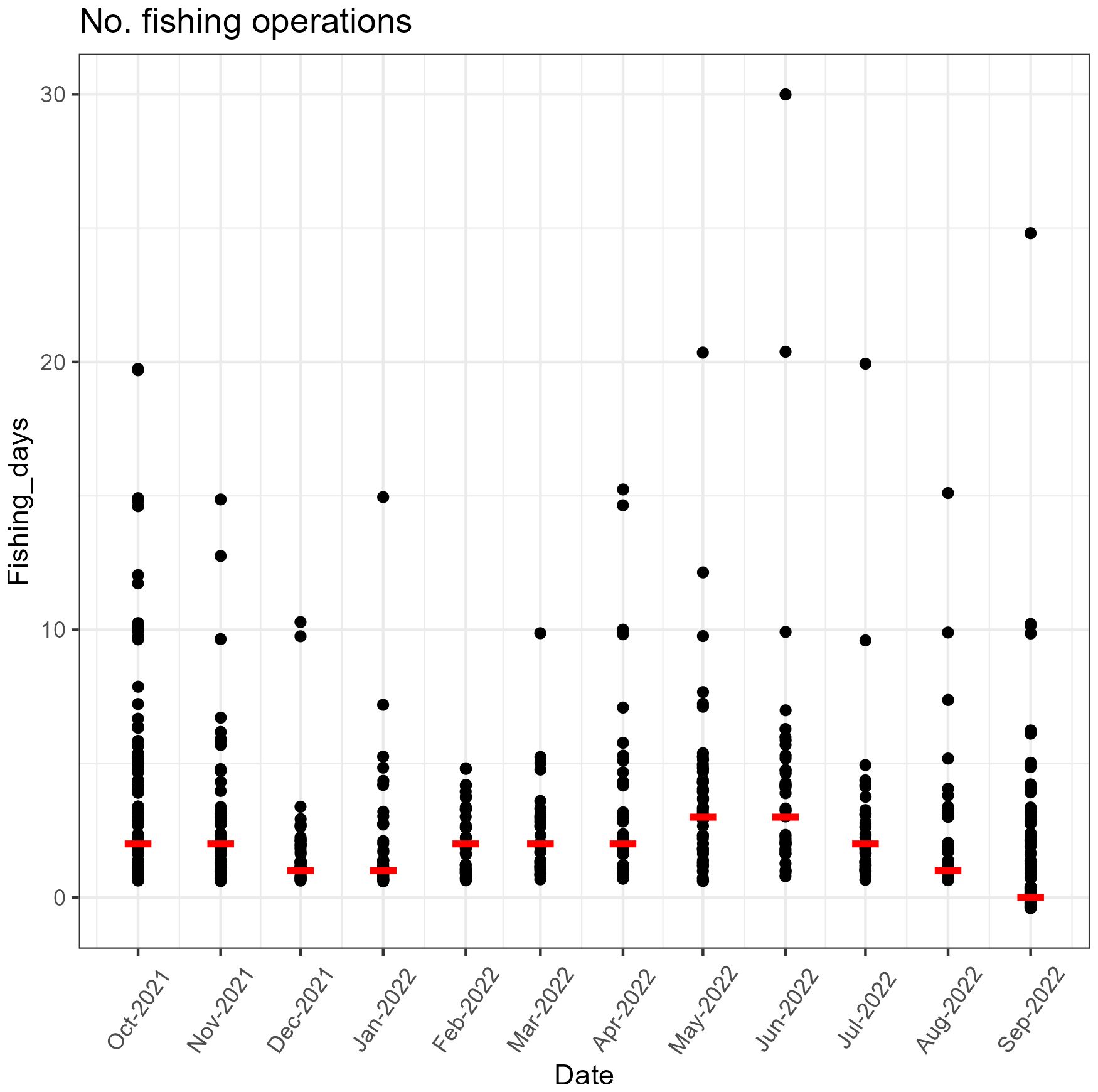
Figure 4 Strip chart showing the monthly fishing days spent by Turkish recreational fishers in the Black Sea from October 2021 to September 2022. The red lines indicate the median values.
The predominant fishing method utilized was shore fishing (80.8%), succeeded by boat fishing (19.0%) and underwater fishing (0.2%). In terms of fishing gear, hook- and- line were the most commonly used (97.5%), trailed by cast nets and seines (0.9%) and longlines (0.6%) (Figure 5).
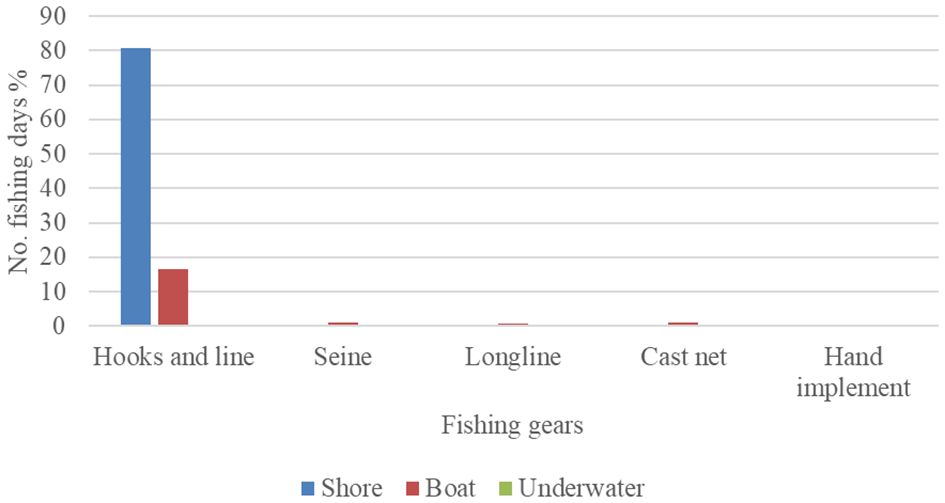
Figure 5 The histogram displays the percentage distribution of fishing days by Turkish recreational fishers in the Black Sea from October 2021 to September 2022, segmented by fishing modality and gear.
3.2.2 Catches
Turkish recreational fishers participating in the recall panel captured a total of 24 fish species in the Black Sea from October 2021 to September 2022 (Table 2). Mediterranean horse mackerel was the most commonly caught species in terms of both number and weight, followed by red mullet and bluefish (Table 2). Approximately 25% of Mediterranean horse mackerel and bluefish caught were released at sea, whereas this percentage decreased to 13% for red mullet.
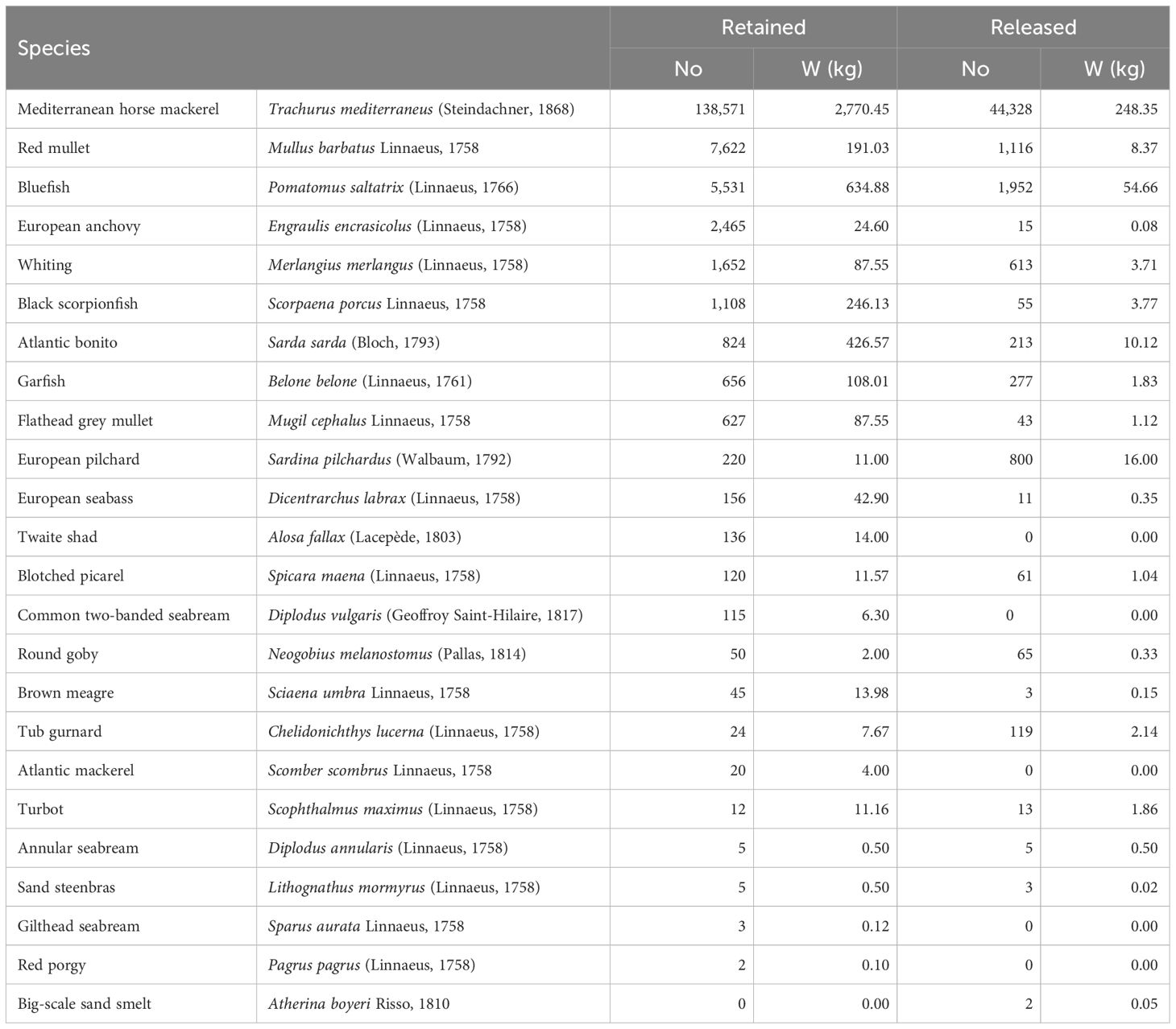
Table 2 List of species captured in the Black Sea by Turkish recreational fishers involved in the recall panel (October 2021 - September 2022), including the number of individuals and the weight of specimens retained and released.
Fishers retained an average of 16.5 kg of fish in the survey year and released an average of 1.2 kg of fish. When extrapolated to the 4.5 million fishers active in the Turkish Black Sea, these figures might contribute to an overall remarkable landing biomass of nearly 74,000 tons. These figures should be validated through future studies, specifically through screening surveys that verify the observed participation rate.
Various fish species were caught throughout the year, with different species available seasonally (Mater and Meriç, 1996; Öztürk, 1999; Bilecenoglu et al., 2002; Lütfiye and Nurettin, 2005; Çetin, 2010). Mediterranean horse mackerel, for instance, can be found in the Black Sea year-round, making it accessible at any time in Türkiye. Bluefish was available between October and December as it migrated along the Black Sea coast from west to east. Atlantic bonito could be found between August and October, while demersal species like red mullet and whiting were available in the summer when the seawater warmed up. Grey mullet migrated close to the Black Sea shore between January and April and was accessible during those months. Garfish could be found between August and December, mainly caught from the boat in the open sea. Black scorpionfish becomes more active when the seawater warms up and can be easily caught by hand line from rocky areas. Seabass and brown meagre are typically found in rocky locations throughout the year.
The length frequency distributions of the three primary species clearly showed that specimens released were predominantly small individuals (Figure 6). In general, recreational fishers typically adhere to the minimum landing sizes of 13 cm Total Length (TL) for Mediterranean horse mackerel and 18 cm TL for bluefish.
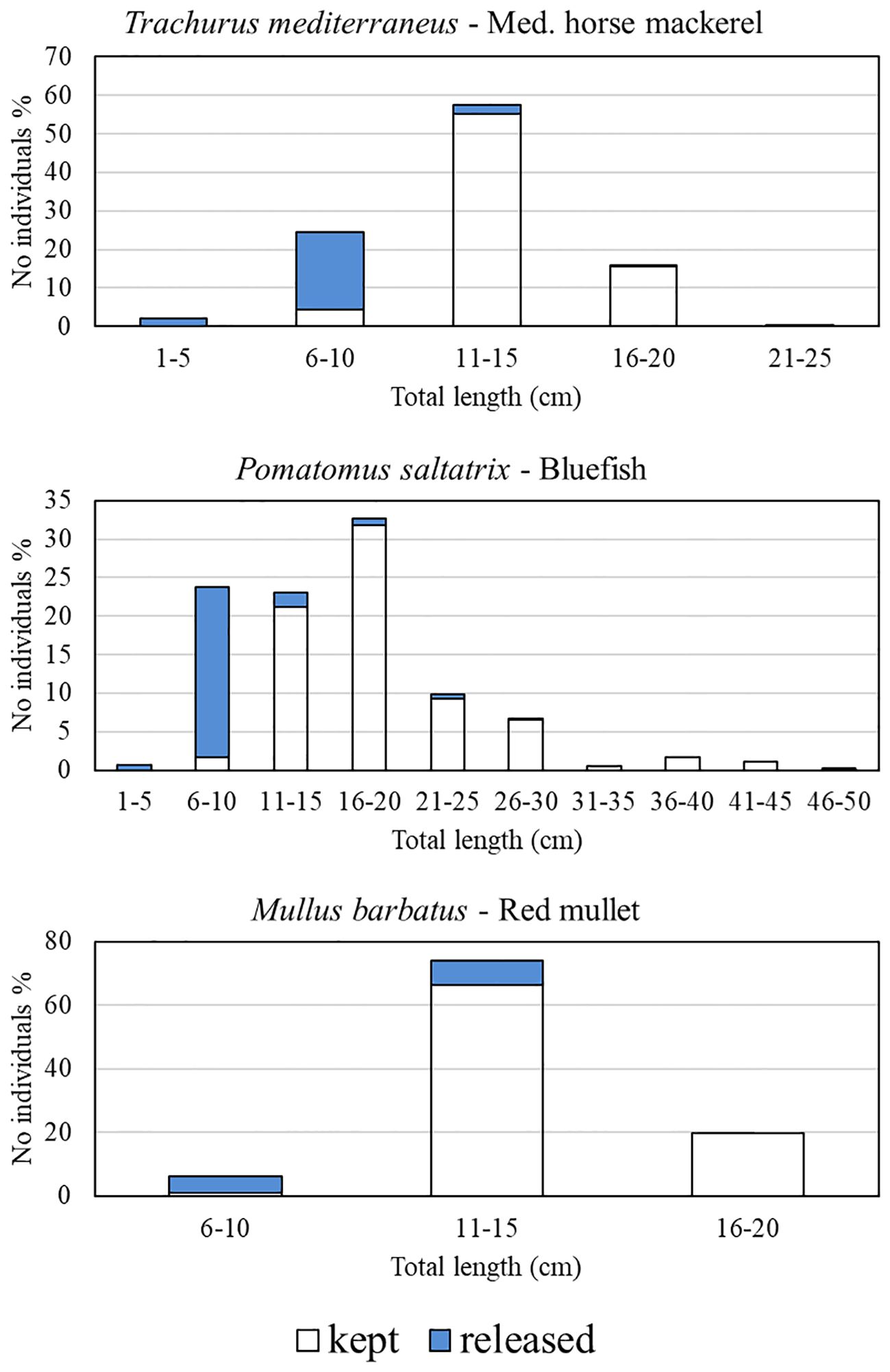
Figure 6 Length frequency distributions of Mediterranean horse mackerel, bluefish and red mullet caught in the Black Sea by Turkish recreational fishers involved in the recall panel (October 2021 - September 2022).
3.2.3 Expenditures
Turkish marine recreational fishers operating in the Black Sea spent an average of 87.70 Euro during the year of data collection, with 36.24 Euro specifically related to the use of a boat, covering expenses for fuel, maintenance, rental, and charter. Food and travel costs were comparable, ranging from 16.23 to 18.76 Euro per year, respectively. Expenditures related to equipment (such as hooks, lines, rods) and baits were relatively minor.
The expenditure pattern aligns with the overall trend of fishing effort, showing a consistent increase from November 2021 to June 2022 (Figure 7).
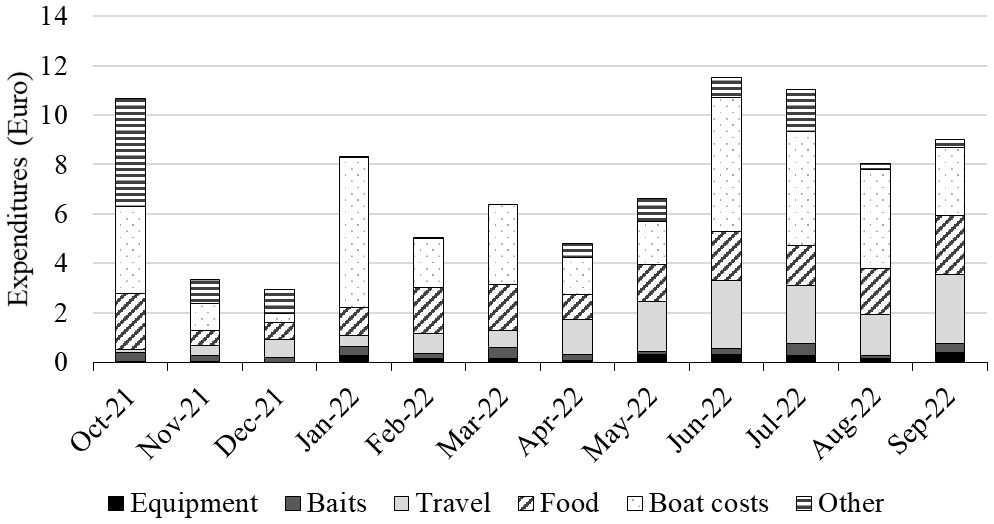
Figure 7 Monthly average expenditures (in Euro) of Turkish marine recreational fishers in the Black Sea, categorized into equipment, baits, travel, food, boat costs, and other expenses.
4 Discussion
The study provides for the first time a comprehensive overview of marine recreational fishing (MRF) practices along the Turkish Black Sea coast, shedding light on participant demographics, participation rates, fishing effort, fishing methods, species diversity, and economic contributions. The findings highlight the deep-rooted passion for MRF among coastal communities, emphasizing the importance of sustainable fishing practices to preserve biodiversity and marine ecosystems. The Black Sea has encountered various ecological challenges such as overfishing, habitat degradation, and pollution, as highlighted by Bat et al. (2005). Irresponsible practices in recreational fishing have the potential to exacerbate these problems. The participation rate observed in this study (18%) significantly surpasses the one computed by Hyder et al. (2017) for all of Europe (1.6%), affirming the substantial social significance of this activity for individuals residing in the Black Sea coastal areas of Türkiye. However, Hyder et al. (2017) found high variability in participation rates across European countries, with figures ranging from 0.2% in Belgium to 33.0% in Norway. Nevertheless, relying on our expert judgement, we believe that the participation rate in the studied area appears very high and warrants reevaluation for confirmation. This is especially pertinent when calculating the comprehensive effort, expenses, and catches, resulting in total figures that significantly surpass our initial expectations. Indeed, the participation rate significantly influences all subsequent estimations and thus warrants careful consideration.
The timing of the screening survey during the COVID-19 pandemic may have contributed to the high participation rate. Pita et al. (2021) found that engaging in marine recreational fishing boosted individuals’ perceived health and well-being during the crisis. Access to marine recreational activities helped mitigate socioeconomic impacts, especially among vulnerable groups. Social restrictions globally increased the demand for outdoor activities, and outdoor leisure pursuits aided social distancing and indirectly reduced the spread of COVID-19, especially in natural environments.
Hence, it’s possible that the number of individuals engaging in recreational fishing surged notably during the survey period, potentially leading to an overestimation of the overall number of people fishing in the Turkish Black Sea (4.5 million). A reassessment would be necessary in the future to validate these figures, particularly when calculating comprehensive efforts, expenses, and catches, which might exceed initial projections significantly. Indeed, the participation rate profoundly impacts all subsequent estimations and, therefore, demands meticulous attention.
In our study, the frequency of fishing trips was predominantly ascribed to a combination of factors, notably the constraints imposed by limited available time, adverse weather conditions, particularly prevalent during the winter months, and economic considerations. These constraints collectively contribute to a reduced opportunity for individuals to engage in recreational fishing. It is noteworthy, however, that amidst these challenges, the fishing activity exhibited a surprising resilience during the COVID-19 pandemic. Contrary to expectations, the impact on recreational fishing appeared to be relatively minimal. This unexpected trend could potentially be attributed to the conscientious adherence to stringent safety protocols by fishing enthusiasts. The commitment to measures such as wearing masks and practicing physical distancing likely played a pivotal role in maintaining a semblance of normalcy in fishing activities despite the disruptions caused by the pandemic. This observation underscores the adaptability and dedication of the recreational fishing community, highlighting the significance of prioritizing safety measures to sustain and safeguard the pursuit of this outdoor activity, even in the face of external challenges.
From an economic standpoint, even when acknowledging the potential bias in the participation rate mentioned earlier, the considerable projected total expenditure of 400 million Euros by marine recreational fishers in the Turkish Black Sea highlights the significant economic influence of this activity on the region. This financial contribution plays a vital role in supporting local economies and businesses, such as fishing gear retailers, hospitality services, and boat rentals. The infusion of such substantial funds not only enhances the economic fabric of the Turkish Black Sea coastal areas but also fosters job creation and sustains livelihoods within these communities. In comparison to the broader context presented by Hyder et al. (2017), where the cumulative expenditure for all EU countries bordering the Mediterranean amounted to 920 million Euros, the Turkish Black Sea’s share could be indeed noteworthy. This contrast may reflect both the scale of marine recreational fishing activities in the Turkish Black Sea and the economic significance of the region’s coastal tourism. Moreover, the economic impact extends beyond direct spending on fishing-related activities. The ripple effect encompasses indirect benefits to various sectors, such as local tourism, restaurants, and associated businesses that cater to the needs and preferences of recreational fishers. This economic symbiosis emphasizes the interdependence between marine recreational fishing and the broader local economy.
Turkish marine recreational fishers (MRF) displayed a distinct focus on specific species, namely Mediterranean horse mackerel, red mullet, and bluefish, resulting in a potential retained biomass of 43,700 tons, 3,000 tons, and 10,000 tons, respectively. Notably, these figures might surpass the commercial landings recorded in 2021, which were 18,053 tons for Mediterranean horse mackerel, 454 tons for red mullet, and 5,612 tons for bluefish, as reported by fao.org/fishery/statistics-query.
The significant disparity between the quantities retained by recreational fishers and those landed commercially might raise concerns about the potential impact of recreational fisheries on crucial commercial fish stocks in the Turkish Black Sea. These observations prompt the consideration of recreational fisheries in stock assessments, as the substantial biomass retained by recreational fishers may have noteworthy implications for the overall health and sustainability of the targeted fish populations.
This study represents the first attempt of estimating the impact of marine recreational fisheries in the Turkish Black Sea. As previously emphasized, the overarching estimate derived from a notably high participation rate indicates a population of fishers nearing 4.5 million individuals, a figure requiring validation through subsequent research.
However, as the data indicates, the impact of recreational fisheries on important commercial fish stocks should be regarded as a critical factor. The considerable quantities caught, especially when compared to commercial landings, underscore the necessity of integrating recreational fisheries data into broader stock assessments. This holistic approach is essential for achieving a comprehensive understanding of the dynamics and sustainability of fish stocks in the Turkish Black Sea. Recognizing the significance of recreational fisheries in stock assessments is a crucial step toward implementing effective management strategies that balance the interests of both recreational and commercial sectors while ensuring the long-term health of marine ecosystems.
One of the key highlights of the study is the anglers’ awareness of conservation efforts, demonstrated through responsible practices such as catch-and-release initiatives. The conscious decision to release a significant portion of caught specimens, especially small individuals, indicates a keen understanding of the need to preserve fish populations for future generations. This conservation-oriented approach aligns with global efforts to mitigate the impact of recreational fishing on marine ecosystems (Arlinghaus and Cowx, 2008) and underscore the vital role anglers play in contributing to the preservation of aquatic biodiversity. Another possible explanation for this enthusiastic behavior might be that the individuals who have agreed to take part in the data collection panel generally possess a deeper understanding of the importance of data collection and are also more sensitive to fisheries conservation issues.
Sustainable fisheries management is essential to balance the enjoyment of recreational fishing with the preservation of marine ecosystems. Therefore, it is crucial to monitor and regulate recreational harvest, especially for popular game fish, to prevent unsustainable exploitation and population declines. Furthermore, collateral impacts such as bycatch and harm to fragile aquatic habitats must be minimized through effective management measures (Cooke and Cowx, 2004).
Furthermore, the study emphasizes the inclusive nature of MRF, as it embraces a diverse range of participants, including women, children, and individuals with disabilities. This inclusivity goes beyond mere participation figures, serving as a testament to the accessibility and adaptability of the activity to people from various backgrounds and abilities. Beyond the individual benefits, the inclusivity of MRF strengthens the societal connection with marine environments. It promotes a shared sense of responsibility for the well-being of aquatic ecosystems and encourages a collective commitment to sustainable practices. The diverse perspectives brought forth by participants of all backgrounds enrich the collective understanding of marine environments, fostering a community-driven approach to conservation.
Data availability statement
The raw data supporting the conclusions of this article will be made available by the authors, without undue reservation.
Author contributions
ME: Data curation, Formal analysis, Funding acquisition, Investigation, Writing – original draft. AC: Conceptualization, Methodology, Project administration, Resources, Supervision, Writing – review & editing. FG: Conceptualization, Data curation, Formal analysis, Methodology, Supervision, Writing – original draft, Writing – review & editing.
Funding
The author(s) declare financial support was received for the research, authorship, and/or publication of this article. The data utilized in this paper originate from a pilot study on marine recreational fisheries conducted by the General Fisheries Commission for the Mediterranean (GFCM) with funding from the European Union.
Conflict of interest
The authors declare that the research was conducted in the absence of any commercial or financial relationships that could be construed as a potential conflict of interest.
Publisher’s note
All claims expressed in this article are solely those of the authors and do not necessarily represent those of their affiliated organizations, or those of the publisher, the editors and the reviewers. Any product that may be evaluated in this article, or claim that may be made by its manufacturer, is not guaranteed or endorsed by the publisher.
References
Arlinghaus R., Cowx I. G. (2008). “Meaning and relevance of the ecosystem approach to recreational fisheries management: emphasis on the importance of the human dimension,” in Global challenges in recreational fisheries. Ed. Øystein A. (Hoboken, United States: Wiley-Blackwell), 56–74.
Bastardie F., Brown E. J., Andonegi E., Arthur R., Beukhof E., Depestele J., et al. (2021). A review characterizing 25 ecosystem challenges to be addressed by an ecosystem approach to fisheries management in Europe. Front. Mar. Sci. 7. doi: 10.3389/fmars.2020.629186
Bat L., Erdem Y., Ustaoglu S., Yardim Ö., Satilmis H. H. (2005). A study on the fishes of the central Black Sea coast of Turkey. J. Black Sea Medit. Env. 11, 281–296.
Bilecenoglu M., Taskavak E., Mater S., Kaya M. (2002). Checklist of the marine fishes of Turkey. Zootaxa 113, 1–194. doi: 10.11646/zootaxa.113.1.1
Bolognini L., Cevenini F., Franza V., Guicciardi S., Petetta A., Santangelo L., et al. (2022). Preliminary estimation of marine recreational fisheries (MRF) in the time of COVID-19 pandemic: the marche region case study (Adriatic sea, Italy). Front. Mar. Sci. 9. doi: 10.3389/fmars.2022.823086
Butler E. C., Childs A. R., Saayman A., Potts W. M. (2020). Can fishing tourism contribute to conservation and sustainability via ecotourism? A case study of the fishery for giant African threadfin Polydactylus quadrifilis on the Kwanza Estuary, Angola. Sustainability 12, 4221. doi: 10.3390/su12104221
Çetin K. (2010). A review of fish fauna in the Turkish Black Sea. J. Black Sea Medit. Env. 16, 195–210.
Cooke S. J., Cowx I. G. (2004). The role of recreational fishing in global fish crises. Bioscience 54, 857–859. doi: 10.1641/0006-3568(2004)054[0857:TRORFI]2.0.CO;2
Cooke S. J., Fulton E. A., Sauer W. H., Lynch A. J., Link J. S., Koning A. A., et al. (2023). Towards vibrant fish populations and sustainable fisheries that benefit all: learning from the last 30 years to inform the next 30 years. Rev. Fish Biol. Fish. 33, 317–347. doi: 10.1007/s11160-023-09765-8
Cooke S. J., Twardek W. M., Lennox R. J., Zolderdo A. J., Bower S. D., Gutowsky L. F., et al. (2018). The nexus of fun and nutrition: Recreational fishing is also about food. Fish Fish. 19, 201–224. doi: 10.1111/faf.12246
Cowx I. G., Arlinghaus R. (2008). “Recreational fisheries in the twenty-first century,” in Global challenges in recreational fisheries. Ed. Øystein A. (Hoboken, United States: Wiley-Blackwell), 75–92.
Drymon J. M., Scyphers S. B. (2017). Attitudes and perceptions influence recreational angler support for shark conservation and fisheries sustainability. Mar. Pol. 81, 153–159. doi: 10.1016/j.marpol.2017.03.001
FAO. (2023). The State of Mediterranean and Black Sea Fisheries 2023 – Special Edition (Rome: General Fisheries Commission for the Mediterranean). doi: 10.4060/cc8888en
Grati F., Carlson A., Carpentieri P., Cerri J. (2021). Handbook for data collection on recreational fisheries in the Mediterranean and the Black Sea (Rome: FAO Fisheries and Aquaculture Technical Paper No. 669). doi: 10.4060/cb5403en
Grip K., Blomqvist S. (2020). Marine nature conservation and conflicts with fisheries. Ambio 49, 1328–1340. doi: 10.1007/s13280-019-01279-7
Hyder K., Weltersbach M. S., Armstrong M., Ferter K., Townhill B., Ahvonen A., et al. (2017). Recreational sea fishing in europe in a global context—Participation rates, fishing effort, expenditure, and implications for monitoring and assessment. Fish. Fisheries. 19, 225–243. doi: 10.1111/faf.12251
Kadagi N. I., Wambiji N., Fennessy S. T., Allen M. S., Ahrens R. N. (2021). Challenges and opportunities for sustainable development and management of marine recreational and sport fisheries in the Western Indian Ocean. Mar. Pol. 124, 104351. doi: 10.1016/j.marpol.2020.104351
Lütfiye E., Nurettin M. (2005). Review of fish fauna of the Sea of Marmara. J. Black Sea Medit. Env. 11, 153–178.
Mater S., Meriç N. (1996). Deniz Balıkları-Pisces in Türkiye Omurgalılar Listesi. Eds. Kence A., Bilgin C. C., Matbaacılık A., Ankara Ş., 129–172.
Ojea E., Lester S. E., Salgueiro-Otero D. (2020). Adaptation of fishing communities to climate-driven shifts in target species. One Earth 2, 544–556. doi: 10.1016/j.oneear.2020.05.012
Øystein A. (2008). Global challenges in recreational fisheries (Hoboken, United States: Wiley-Blackwell).
Öztürk B. (1999). Black Sea biological diversity Turkey, GEF Black Sea Environmental Program (New York, United States: United Nations Publications Sales No. E.99.III.R.1, Black Sea Environmental Series), 9.
Pita P., Ainsworth G. B., Alba B., Anderson A. B., Antelo M., Alós J., et al. (2021). First assessment of the impacts of COVID-19 pandemic on global marine recreational fisheries. Front. Mar. Sci. 8. doi: 10.3389/fmars.2021.735741
Potts W. M., Saayman M., Saayman A., Mann B. Q., van der Merwe P., Britz P., et al. (2022). Understanding the economic activity generated by recreational fishing in South Africa provides insights on the role of recreational fisheries for social development. Fish. Manage. Ecol. 29, 29–43. doi: 10.1111/fme.12515
Pouso S., Uyarra M. C., Borja A. (2018). Recreational fishers’ perceptions and behavior towards cultural ecosystem services in response to the Nerbioi estuary ecosystem restoration. Estuar. Coast. Shelf Sci. 208, 96–106. doi: 10.1016/j.ecss.2018.04.033
Schafft M., Wegner B., Meyer N., Wolter C., Arlinghaus R. (2021). Ecological impacts of water-based recreational activities on freshwater ecosystems: a global meta-analysis. Proc. R. Soc B 288, 1–13. doi: 10.1098/rspb.2021.1623
Shen H., Song L. (2023). Implementing ecosystem approach to fisheries management in the western and central pacific fisheries commission: challenges and prospects. Fishes 8, 198. doi: 10.3390/fishes8040198
Tsafoutis D., Metaxas T. (2021). Fishing tourism in Greece: defining possibilities and prospects. Sustainability 13, 13847. doi: 10.3390/su132413847
Keywords: marine recreational fishing, Turkish Black Sea, sustainability, catch-and-release, socio-economic impact, environmental impact, telephone screening survey, recall survey
Citation: Erbay M, Carlson A and Grati F (2024) Evaluating the unexplored recreational fishing in the Turkish Black Sea: socio-economic significance and environmental impact. Front. Mar. Sci. 11:1386911. doi: 10.3389/fmars.2024.1386911
Received: 16 February 2024; Accepted: 16 April 2024;
Published: 23 May 2024.
Edited by:
Angel Borja, Marine Research Division, SpainReviewed by:
Sandra Agius Darmanin, University of Malta, MaltaLeonardo A. Venerus, Consejo Nacional de Investigaciones Científicas y Técnicas (CESIMAR - CONICET), Argentina
Copyright © 2024 Erbay, Carlson and Grati. This is an open-access article distributed under the terms of the Creative Commons Attribution License (CC BY). The use, distribution or reproduction in other forums is permitted, provided the original author(s) and the copyright owner(s) are credited and that the original publication in this journal is cited, in accordance with accepted academic practice. No use, distribution or reproduction is permitted which does not comply with these terms.
*Correspondence: Fabio Grati, ZmFiaW8uZ3JhdGlAY25yLml0
 Murat Erbay1
Murat Erbay1 Fabio Grati
Fabio Grati